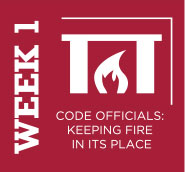 By Monica Brown, Tulalip News Writer
By Monica Brown, Tulalip News Writer
Tulalip, WA – May is National Building Safety Month (NBSM) as proclaimed by President Barack Obama in 2013, as a way to “encourage citizens, government agencies, businesses, nonprofits, and other interested groups to join in activities that raise awareness about building safety.” For NBSM, the month of May is broken down into four weeks and the focus put on a new subject for each week, fire safety, disaster safety, backyard safety and green and sustainable building.
The Tulalip Tribes Community Development department is participating in NBSM and would like to make Tulalip residents aware of the hazards in and around the home as well as tips for prevention and safety. Community Development is providing pamphlet information that can be picked up at the Tulalip administration building for the entire month of May, see below for contact information.
The first week of NBSM is designated for fire safety in and around the home, Keeping Fire in its Place. According to the U.S. Fire Administration, each year throughout the U.S., 17,500 people are injured in fires and over 3,400 Americans perish in fires with about 1/3 of those victims being Senior citizens. A few things to consider during fire safety week are to check your smoke alarms, establish an evacuation plan, and purchase a fire extinguisher. It’s also a good time teaching children about fire safety. Annually, children of all ages set over 35,000 fires (U.S. Fire Administration statistic).
Fire Extinguisher information: There are multiple types of extinguishers used for specific flammable materials and what works for one may not work for another. In case of a fire, please do not rely solely on a extinguishing it yourself; call the fire department as soon as you notice the fire and make sure you can get to safety before trying to extinguish it on your own.
· Class A extinguishers put out fires in ordinary combustible materials such as cloth, wood, rubber, paper, and many plastics.
· Class B extinguishers are used on fires involving flammable liquids, such as grease, gasoline, oil, and oil-based paints.
· Class C extinguishers are suitable for use on fires involving appliances, tools, or other equipment that is electrically energized or plugged in.
· Class D extinguishers are designed for use on flammable metals and are often specific for the type of metal in question. These are typically found only in factories working with these metals.
· Class K fire extinguishers are intended for use on fires that involve vegetable oils, animal oils, or fats in cooking appliances. These extinguishers are generally found in commercial kitchens, such as those found in restaurants, cafeterias, and caterers. Class K extinguishers are now finding their way into the residential market for use in the kitchen.
· Multi-purpose fire extinguishers are also made that combine uses such as class “B-C” or “A-B-C” and can be used on two or more of the above type fires.
Some fire districts in Snohomish County offer free smoke alarm installations and fire extinguisher training. Please contact your fire district to schedule a home smoke alarm installation or fire extinguisher training.
Nearby local fire departments:
Tulalip Bay Fire Department Snohomish Co. Fire District 15, 7812 Water Works Rd Tulalip, WA 98271-9631, 360-659-2416
Marysville Fire District, 1094 Cedar Avenue Marysville, WA 98270, 360-363-8500
For pamphlet information about NBSM contact, Orlando Raez, Tulalip Tribes Community Development, 360-716-4214.
10 Important tips to remember for fire safety and awareness
Put a smoke alarm on every level of your home and outside each sleeping area. Put a smoke alarm inside every bedroom.
Make sure your smoke alarms work. Test your smoke alarms. Push the test button. You will hear a loud noise. If you don’t hear the noise, you need a new battery or a new alarm.
Make sure the smoke alarm always has a good battery. Put a new battery in the alarm every year.
Smoke alarms with long-life batteries will work for up to 10 years. You do not change the battery.
Smoke alarms do not last forever. Get new smoke alarms every 10 years.
Tell your family what to do if they hear the smoke alarm. Make an escape plan so everyone knows how to get out fast. Pick a meeting place outside the home where everyone will meet. Some children and older adults cannot hear the smoke alarm when they are sleeping. Make a plan for how to wake them up. Practice your escape plan with everyone in your family two times each year.
Install home fire sprinklers in your home. Home fire sprinklers and working smoke alarms greatly increase your chance of surviving a fire. Sprinklers are affordable and they can increase your property value and lower your insurance rates.
Portable heaters need their space. Keep anything that can burn at least three feet away.
If you live in an area where homes are located in or close to forests or vegetation areas, you should think about the following safety tips.
Install 1/8 inch or smaller mesh screening that cannot burn on attic/soffit vents and around wood decks to keep out embers. Install spark arrestors on fire place chimneys or wood stove vents.
Keep all items that can burn away from your home. Clean leaves from your gutters. Clear dead leaves and branches from shrubs and trees.
